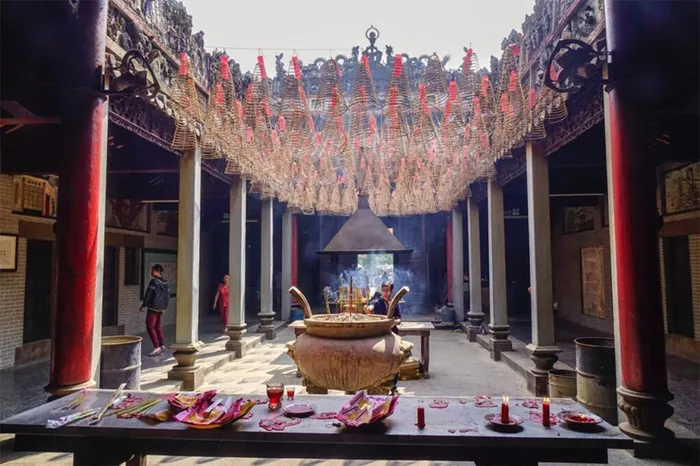The Jade Emperor Hall is a special building found in many buddhist temples. It is dedicated to the Jade Emperor, who is a very important deity in Chinese folk religion and Taoism. The Jade Emperor is seen as the ruler of heaven, earth, and all worlds. Although Buddhism focuses on Buddha and bodhisattvas, many temples also include halls for local or popular deities like the Jade Emperor. This shows how buddhist temple architecture often blends different cultural beliefs.
The Role of the Jade Emperor in Buddhism
In Buddhist teachings, the Jade Emperor is not a Buddha or bodhisattva but a powerful god who manages the universe. Devotees often pray to him for protection, peace, and good fortune. In some temples, the Jade Emperor Hall helps bridge the gap between Buddhism and traditional Chinese beliefs. This is why many Buddhists respect him as a divine figure who supports the Dharma.
Architectural Style of the Jade Emperor Hall
Basic Layout and Structure
The Jade Emperor Hall is designed with careful attention to balance and symmetry. It usually sits at the front or center of a temple complex. The building often has a square or rectangular shape, symbolizing stability and earth. The roof is curved and decorated with colorful tiles and figures of dragons, phoenixes, and other mythological animals. These decorations symbolize power and protection.
Roof and Decorations
The roof style of the Jade Emperor Hall is typical of buddhist architecture. It has upturned eaves that look like wings. This shape helps protect the building from evil spirits and bad luck. The roof ridge is often decorated with small statues of dragons or other creatures. These details add to the sacred feeling of the hall and show the skill of ancient craftsmen.
Materials and Colors
The materials used for building the Jade Emperor Hall include wood, stone, and glazed tiles. Wood is carved with fine patterns of clouds, flowers, and animals. Red and gold are the main colors of the hall. Red means good luck and happiness, while gold symbolizes wealth and holiness. These colors help create a warm and inviting atmosphere for worshippers.
Interior Design
Inside the Jade Emperor Hall, the space is calm and peaceful. The main statue of the Jade Emperor sits on a throne in the center. The statue is often large and richly decorated with robes and a crown. Around the statue, there may be smaller figures of other gods and immortals. The walls are painted with scenes from Taoist and folk stories about the Jade Emperor’s deeds.
Deity Worship in the Jade Emperor Hall
Who is Worshipped in the Jade Emperor Hall?
The main deity worshipped in this hall is the Jade Emperor, also known as Yu Huang or Tian Gong. He is the supreme god who governs all heavenly and earthly realms. People come to pray to him for justice, peace, and blessings. Besides the Jade Emperor, other gods related to heaven and earth may also be honored here, like the Three Pure Ones or the Eight Immortals.
Common Worship Practices
Worship in the Jade Emperor Hall includes lighting incense, offering fruits and flowers, and chanting prayers. Devotees ask the Jade Emperor for protection from disasters and help with family matters. The most important festival related to the Jade Emperor is the Jade Emperor’s Birthday, celebrated on the ninth day of the first lunar month. On this day, special ceremonies, offerings, and performances take place in the hall.
Symbolism in Worship
Every part of the worship practice has meaning. Burning incense represents respect and connection to the spiritual world. Offering fruits and sweets shows gratitude and sincerity. The prayers ask for harmony between humans and nature, which is a key idea in both Buddhism and Taoism. Worship at the Jade Emperor Hall reminds people to live morally and follow the path of kindness and wisdom.
Cultural Heritage of the Jade Emperor Hall
Historical Background
The Jade Emperor Hall has a long history. It first appeared in Chinese temples hundreds of years ago, combining Taoist ideas with local beliefs. Over time, it became common in many Buddhist temples in China and other East Asian countries. This shows how religious traditions can mix and grow together, creating rich cultural heritage.
The Jade Emperor Hall and Local Communities
In many towns and villages, the Jade Emperor Hall is a center of social and cultural life. People gather here during festivals to celebrate and strengthen community bonds. The hall also serves as a place for teaching traditional values like respect, honesty, and charity. This role helps keep local culture alive and passes it to future generations.
Preserving the Jade Emperor Hall Today
Many Jade Emperor Halls are protected as cultural relics because of their artistic and historical value. Conservation efforts include restoring old buildings and promoting traditional rituals. These halls attract tourists and believers alike, helping people learn about Chinese religious culture and temple architecture.
Modern Influence and Adaptation
Today, the Jade Emperor Hall continues to influence art, literature, and popular culture. Its image appears in paintings, movies, and festivals. Some modern temples build new halls inspired by traditional styles but use modern materials. This shows respect for the past while adapting to present needs.
Conclusion
The Jade Emperor Hall is more than just a building. It is a place where architecture, faith, and culture meet. Its design reflects ancient craftsmanship and deep symbolism. Worship in the hall connects people to powerful spiritual forces and traditional values. As part of buddhist temples, the Jade Emperor Hall shows how Buddhism can blend with local beliefs to create a rich and living cultural heritage. Preserving this hall means preserving a treasure of human spirituality and history.

